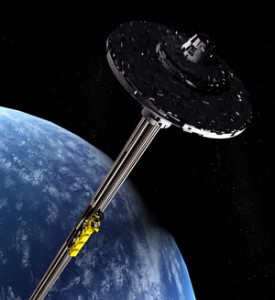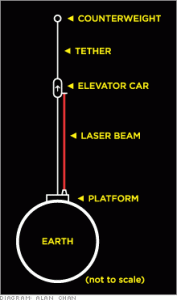
Even though the privatization of space flight might make it possible for (extremely rich) people to realize their dreams of travelling to space, I’m waiting for the day when I can step into an elevator and push the button for floor 1,000,000,006.
While Arthur Clarke takes the credit for popularizing the idea in his 1978 book Fountains of Paradise, we’ve actually been imagining such a structure for a long time. The space elevator is essentially a futuristic spin on Jack’s beanstalk. In 1895, a Russian scientist suggested the earliest prototype for a space elevator, the “Celestial Castle,” which would orbit earth while tethered to a structure that looks a bit like the Eiffel Tower.
When asked about a timeline for the realization of the space elevator, Arthur Clarke said, “Probably about 50 years after everybody quits laughing.” Well, it seems we’ve stopped laughing–there’s an International Space Elevator Consortium, which I’d give my right rocket booster to join; the 61st International Astronautical Congress in Prague earlier this year included a panel about the space elevator; and NASA recently held a Strong Tether Contest at the Space Elevator Conference sponsored by the Space Engineering and Science Institute.
In the 1990s, NASA conducted a feasibility study of space elevators. The design envisioned by scientists positions the center of the elevator’s mass in a stationary orbit around earth. A counterweight, such as an asteroid or space port, beyond the center of mass would prevent the elevator from falling down to earth. A power source would propel elevator cars up a cable that runs from a stationary platform on the ground to the mass center. Such a design would require three basic parts: the elevator car, a power source, and the cable. 
We’ve already got robots that can climb ropes while lifting heavy objects (where were these in gym class?), so presumably the elevator car would be an advanced version capable of carrying bigger and heavier materials. This part is relatively easy.
A harder question is how to propel the elevator cars up the cable. We need a wireless power transmission device of some kind, and the most popular theory is that we’ll use lasers. These lasers would be located on the ground platform and would point up to the elevator itself, which would have a dish capable of capturing and converting the lasers into propulsion power. The ability to convert lasers into power is one we already have, but we’ve never converted the amount of power it would take to move the space elevator. Another problem is that as the elevator ascends, the laser beams would become scattered and diffuse, and possibly blocked by clouds, which means that the majority of the beam wouldn’t actually reach the dish. We’re still working on this one.
Harder still is the elevator cable. Arthur Clarke imagined a “continuous pseudo-one dimensional diamond crystal,” and what scientists have come up with isn’t so different–carbon nanotube material. It’s 100 times stronger than steel, but weighs 1/6th as much. This material is actually a ribbon, and is thinner than paper (the strong tether competition primarily involves carbon nanotube designs). While these nanotubes are the strongest material known to man, we’ve never used them on a scale big enough to build anything–essentially, we have to convert micromaterial to macromaterial, which is much easier said than done and may require inventing an entirely new material.
Even if we figure out a way to invent a cable made from carbon nanotube material, it wouldn’t be immune from breakage. Storms on the ground in the area of the platform, lightning in the air, cosmic rays, radiation, and space debris could all cause breakage. While this might seem dangerous, I think the important thing is that it’d be perfectly safe to play hockey inside the space elevator.
In another potential space elevator cable setback, recent calculations by a scientist at the Polytechnic of Turin revealed that when flawlessly intact, an individual nanotube can withstand 100 gigapascals of tension, but if the nanotube is missing even a single atom, its ability to withstand tension decreases by as much as 30%. Additionally, recent studies of macromaterials show that when many carbon nanotubes are connected, their strength decreases drastically–they can withstand only about 1 gigapascal of tension. What we lose in elevator science we gain in learning that there’s a unit of measurement as cool as a gigapascal.
This also explains why no one won this year’s Strong Tether Contest.
Despite the cable problem, scientists will keep working on the space elevator. It’s certainly far cheaper (and more environmentally friendly) than launching people and objects up in rockets. And when our elevators succeed in moving toward the stars, we can finally address some other pressing issues, such as what kind of music will be played on these elevators. And maybe, just maybe, as the elevator is about to stop, we can jump and float like we’ve always dreamed.

3 Responses to In Event of Cosmic Radiation, Please Take the Stairs